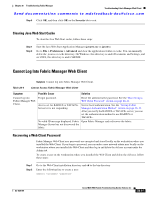Cisco MDS-9124 Troubleshooting Guide - Page 508
Troubleshooting Performance Manager, Setting Fabric Manager Authentication Method
 |
View all Cisco MDS-9124 manuals
Add to My Manuals
Save this manual to your list of manuals |
Page 508 highlights
Troubleshooting Performance Manager Chapter 26 Troubleshooting Fabric Manager Send documentation comments to [email protected] Step 3 Step 4 Step 5 Step 6 Stop Fabric Manager Web Client if it is running. If you installed this on Windows, you can stop the service using Windows Services under Administrative Tools. Launch Fabric Manager Web Client. Click Admin > Configure > Web Users > Local Database. You see the list of users in the local database. Select the user that you want to delete and click Delete to remove the old user. Setting Fabric Manager Authentication Method To set the authentication method used by Fabric Manager (including the Web Client), follow these steps: Step 1 Step 2 Step 3 Go to the Fabric Manager installation directory and open cisco_mds9000\AAA.properties in an edit program (for example, Notepad on Microsoft Windows). Set authentication.mode=local. Restart Fabric Manager. Troubleshooting Performance Manager Performance Manager gathers network device statistics historically and provides this information graphically using a web browser. It presents recent statistics in detail and older statistics in summary. Performance Manager also integrates with external tools such as Cisco Traffic Analyzer. The Performance Manager has three operational stages: • Definition-The Flow Wizard sets up flows in the switches. • Collection-Reads the configuration from the database, the flow configuration from the switches, and collects the desired information. • Presentation-Generates web pages to present the collected data. Performance Manager uses a round-robin database to hold the statistical data collected from the fabric. This data is stored based on the configured parameters in the collection configuration file. At each polling interval, Performance Manager gathers the relevant statistics and stores them in the round-robin database. This database is a fixed size and will not grow beyond its preset limits. Performance Manager creates a series of archived data to hold summarized information present in the real-time round-robin database. This archived data is used to generate daily, weekly, monthly, and yearly consolidated reports. In this way, Performance Manager maintains significant historical data without the cost of an ever-increasing database size. This section contains the following topics: • Performance Manager Generates Java Error, page 26-13 • Performance Manager Not Working, page 26-13 26-12 Cisco MDS 9000 Family Troubleshooting Guide, Release 3.x OL-9285-05















